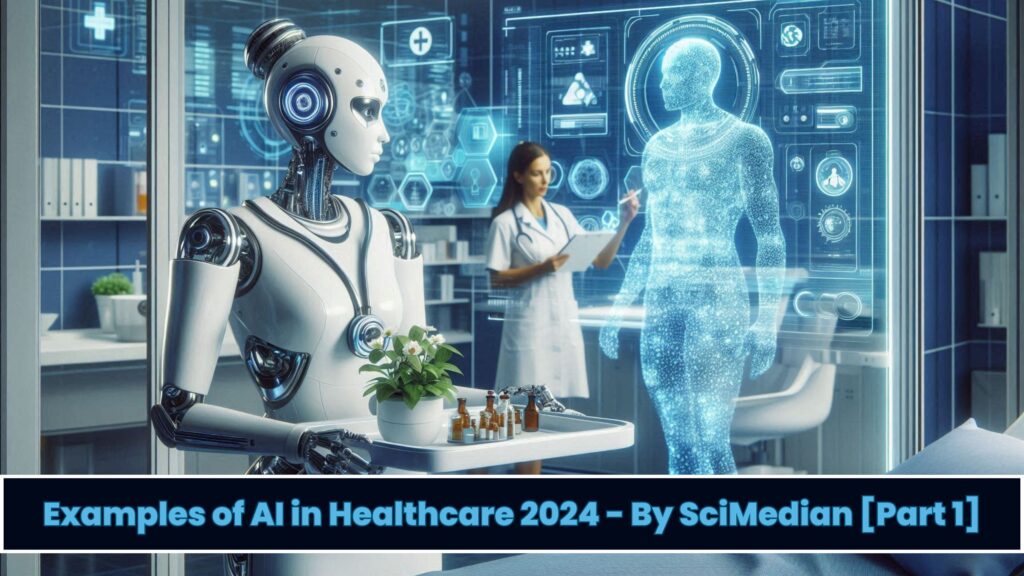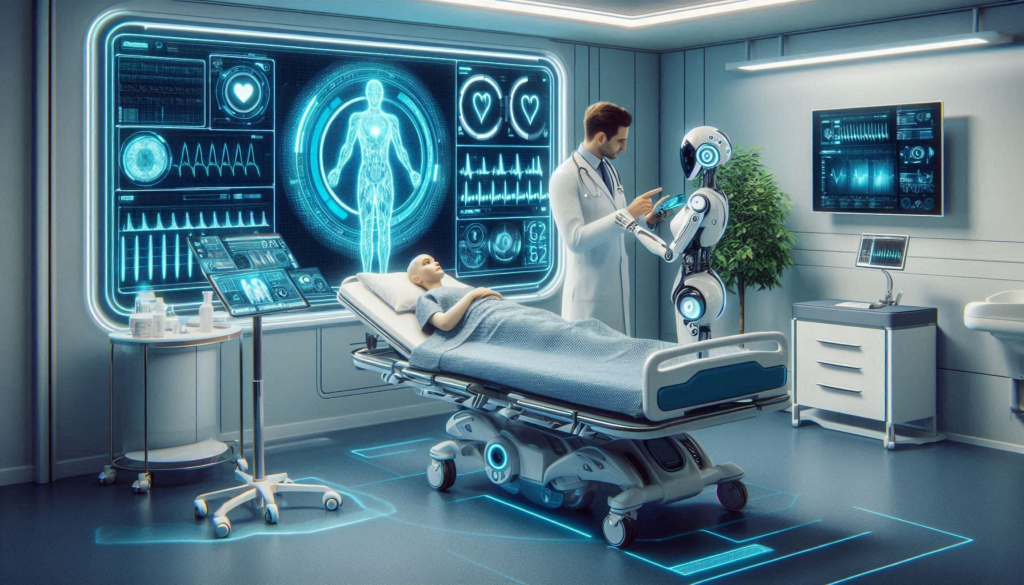Blog Introduction
Welcome to SciMedian’s New blog post. In today’s rapidly evolving healthcare landscape, artificial intelligence (AI) is at the forefront of innovation, revolutionizing multiple aspects of medical practice. From enhancing diagnostic accuracy to streamlining workflows, AI is transforming patient care and outcomes. This blog delves into specific examples of AI applications in healthcare, highlighting their significance and impact. We will explore advancements in patient positioning during CT scans, accelerated MRI image acquisition, simplified ultrasound measurements, and the pioneering role of IBM Watson in healthcare. Additionally, we will examine the growing influence of virtual health assistants and chatbots in providing efficient and effective patient care. Join us as we navigate through these groundbreaking developments and their implications for the future of healthcare.

1. Precision in Patient Positioning and CT Image Reconstruction
Advances in healthcare technology, particularly in the field of computed tomography (CT), have significantly improved patient outcomes. One critical aspect is the precise positioning of patients during CT exams, which directly impacts image quality, radiation exposure, and diagnostic accuracy.
- Philips Precise Position: This innovative approach utilizes Artificial Intelligence (AI) to quickly and accurately position patients for successful CT scans. The AI-enabled camera, equipped with sophisticated convolutional neural network technology, adapts to individual patients. By automating patient positioning, it reduces radiation dose and image noise, ensuring optimal results.
- Automated Anatomical Landmarks: The Precise Position AI algorithm automatically detects 13 anatomical landmarks, such as key points on the patient’s body. In 99% of cases, it selects the patient’s orientation (prone or supine) and head-first or feet-first position without manual adjustments. This automation streamlines the process, saving valuable time and enhancing operator consistency.
- Workflow Efficiency: Radiology technologists and imaging directors often face inefficiencies in their work. By integrating AI-driven patient positioning, they can spend less time setting up scans and more time interacting with patients. The 23% reduction in patient positioning time directly contributes to workflow improvement and staff well-being.
2. Speeding Up MR mage Acquisition
Magnetic Resonance Imaging (MRI) is a powerful diagnostic tool, but its traditional sequential data acquisition process can be time-consuming. To address this limitation, researchers and clinicians have explored various techniques to accelerate image acquisition. Here are some methods used to speed up MR imaging:
- Fast Spin Echo (FSE) Sequences: FSE sequences acquire multiple lines of k-space within each heartbeat. By generating a train of spin echoes with multiple 180° refocusing pulses, FSE fills up k-space more rapidly, resulting in shorter image acquisition times.
- Super-Resolution and Denoising AI: Artificial intelligence (AI) solutions enhance MR acquisition times and image quality. For instance, Mount Sinai Health Systems in New York City implemented AI applications that leverage super-resolution and denoising techniques. These algorithms improve image quality while reducing acquisition time. In lumbar spine studies, AI-enhanced reconstruction reduced scan time by up to 46% compared to conventional scans.
- Undersampling k-Space Signals: To achieve faster MR imaging, researchers often undersample k-space signals. Although this approach poses an ill-posed problem, constrained optimization processes help reconstruct high-quality images from the acquired data.
3. Simplifying Ultrasound Measurements
Ultrasound examinations play a crucial role in monitoring fetal development during pregnancy. While the cryptic codes and markings on ultrasound images may seem mysterious, they serve an essential purpose for healthcare professionals. Let’s demystify these abbreviations and explore their significance:
- Gestational Age and Estimated Due Date: At the top left of the ultrasound image, you’ll find the mother’s name and the date of the scan. The first date represents the gestational age, while the subsequent date indicates the estimated due date. These dates guide prenatal care and help track the baby’s growth.
- Fetal Measurements:
- Biparietal Diameter (BPD): Measures the width of the baby’s skull, aiding in assessing brain development.
- Femur Length (FL): Determines the length of the upper leg bone, providing insights into overall growth.
- Head Circumference (HC): Indicates the size of the baby’s head, crucial for assessing brain health.
- Occipitofrontal Diameter (OFD): Measures from the root of the nose to the base of the skull, aiding in facial assessment.
- Abdominal Circumference (AD): Evaluates chest area and internal organs like the heart, lungs, and stomach.
4. IBM Watson: Transforming Industries with AI
IBM Watson, a powerful artificial intelligence (AI) platform, has made significant strides across various domains. Let’s explore some impactful use cases where Watson is making a difference:
Healthcare:
- Data Analysis: Watson’s ability to process and understand complex medical data benefits healthcare professionals. It assists in diagnosing diseases, predicting patient outcomes, and recommending personalized treatment plans.
- Radiology: Watson aids radiologists by analyzing medical images (such as CT scans and MRIs) for anomalies, improving accuracy and efficiency.
- Drug Discovery: Watson accelerates drug discovery by analyzing vast datasets, identifying potential candidates, and predicting their efficacy.
5. Virtual Health Assistants and Chatbots: Transforming Healthcare
In the ever-changing landscape of healthcare, virtual assistants and chatbots are emerging as powerful tools to enhance patient care and streamline medical processes. These digital companions leverage artificial intelligence (AI) and advanced technologies to provide valuable services. Let’s explore their functions and real-world examples:
- Patient Interaction:
- AI Chatbots: Available 24/7, these chatbots engage with patients, answering medical queries and providing reliable advice.
- Symptom Assessment: Apps like Ada Health offer AI-driven symptom checkers that often diagnose conditions earlier than doctors.
- Appointment Scheduling:
- Virtual assistants simplify the booking process, allowing patients to schedule appointments seamlessly.
- Imagine a chatbot like Sensely monitoring your recovery progress after surgery.
- Monitoring and Follow-up:
- These assistants track health metrics, send medication reminders, and ensure continuous care.
- Administrative Efficiency:
- Virtual assistants automate billing, coding, and electronic health record (EHR) updates, freeing up healthcare professionals’ time.
Thank You








